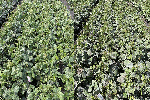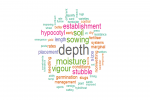-
 Soil and Nutrition, 26 Feb 2023
Soil and Nutrition, 26 Feb 2023Weighing nitrogen fertiliser options in an uncertain future
Estimating in-season nitrogen demand based on estimated target yield is highly dependent on seasonal influences. A spreadsheet using simple nitrogen budgeting enables a potential rate to be evaluated against each possible seasonal outcome to better demonstrate the relative risk and reward.
-
 Soil and Nutrition, 25 Feb 2023
Soil and Nutrition, 25 Feb 2023Nitrogen price remains secondary to yield and protein targets
Recent nitrogen price hikes have focused debate on input costs. But calculations show that agronomically recommended fertiliser rates can still be profitable even when urea prices triple. Replacing depleted soil nitrogen stores is also vitally important, particularly after high-yielding seasons.
-
 Soil and Nutrition, 24 Feb 2023
Soil and Nutrition, 24 Feb 2023Advanced genetic techniques target protein and yield
Genetic material targeting the elusive combination of improved wheat yield and grain protein content has been identified using advanced analysis of plant traits. The genes, which control multiple processes within the plant, will be made available to Australian breeding companies.
-
 Soil and Nutrition, 23 Feb 2023
Soil and Nutrition, 23 Feb 2023Agronomy still top priority for nitrogen fertiliser decisions
A recent survey of growers in Western Australia has shown that growers place a strong emphasis on balancing seasonal soil moisture and yield potential alongside the long game of maintaining soil fertility. The results demonstrate that growers place a strong emphasis on balancing seasonal soil moisture and yield potential alongside the long game of maintaining soil fertility.
-
 Soil and Nutrition, 22 Feb 2023
Soil and Nutrition, 22 Feb 2023Liming a risky partner for sulfate of ammonia
Anecdotal evidence suggests that the practice of applying sulfate of ammonia in close succession to surface lime is a risk for ammonia volatilisation. The practice is common enough in Western Australia to raise concerns and research is underway to quantify the risks.
-
 Soil and Nutrition, 21 Feb 2023
Soil and Nutrition, 21 Feb 2023Getting a firm grip on nitrogen losses
Denitrification and volatilisation are the two main gaseous loss pathways for nitrogen from cropping systems, but there are still many gaps in our understanding of the mechanisms and importance of these losses across Australian grain growing regions.
-
 Soil and Nutrition, 20 Feb 2023
Soil and Nutrition, 20 Feb 2023National study into nitrogen losses
Growers spend around $1.1 billion on nitrogen fertiliser each year, yet 25 to 70 per cent of applied nitrogen can be lost from the system. A national investment aims to plug the gaps in our understanding of nitrogen loss pathways in Australian cropping systems.
-
 Soil and Nutrition, 19 Feb 2023
Soil and Nutrition, 19 Feb 2023Highly productive crops can be more greenhouse gas efficient
Nitrogen fertiliser is the largest source of greenhouse gas emissions in the grains industry. Analysis has found that by improving nitrogen use efficiency, growers stand to increase yields and generate a 10 per cent reduction in the intensity of emissions – including emissions associated with fertiliser manufacture.
-
 Soil and Nutrition, 18 Feb 2023
Soil and Nutrition, 18 Feb 2023Rewriting nitrogen fertiliser ‘rules of thumb’
Commonly used rules of thumb, which advisers and growers use to make fertiliser decisions, are based on a nitrogen fertiliser uptake of around 50 per cent of that applied, but Victorian research undertaken in growers’ paddocks puts that figure at just 35 per cent.
-
 Soil and Nutrition, 17 Feb 2023
Soil and Nutrition, 17 Feb 2023Protecting soil fertility is paramount for continuous cropping
Soil organic matter, which is critical for healthy soils and sustainable agricultural production, is declining under continuous cropping. This means more fertiliser, especially nitrogen, and the best management practices are needed to protect soils and maintain grain production levels.
-
GRDC News
+
GRDC News

Queensland on the pulse with mungbean breakthrough
Queensland’s mungbean industry is set for a major boost with the launch of two new...

Snail and slug baiting methods put to the test
A research project is underway to aid Australian grain growers to manage snail and slug...

Industry consultant honoured with GRDC award
The 2025 northern GRDC Seed of Light has been awarded to Independent Consultants Australia Network...

Victorian agronomist and scientist each win grains award
Agricultural consultant Cam Nicholson and research scientist Dr Audrey Delahunty each received awards this week...

Acid soil research priorities identified
A National Soil Acidity Workshop held in Adelaide in February has identified and prioritised transformational...

GRDC regional Updates to kick off in Cunderdin
Western Australian grain growers can learn about the latest research and innovations relevant to their...

New sowing date calculators could lift wheat, barley yields
The Grains Research and Development Corporation (GRDC) has made a significant investment in the National...

Automated biosecurity sentinels guarding the modern farm
GRDC’s role in the recent $21 million investment in the iMapPESTS project marks a significant...
ADVERTISEMENT -
Agronomy
+
Agronomy

Request the data
When considering new varieties, requesting independent data is important.

Impact of NVT extends beyond variety selection
The National Variety Trials (NVT) system adds value to the agricultural research pipeline in ways...

Advancing cereal yield frontiers
GRDC is investing in research to identify agronomic tactics to help growers achieve yield potential,...

The quest for the perfect rhizobia–legume matches
GRDC has made a groundbreaking investment in creating the world’s largest collection of rhizobia, significantly...

Frost research set to target ear architecture
After many years of hearing stories about wheat varieties with different-shaped ears being more tolerant...

Cell membranes key to promising frost approach
The ability of plant cell membranes to flex instead of breaking or bursting at low...

To plant, or not, on late summer rain?
Higher returns are possible from a farming system that can flexibly optimise sowing opportunities throughout...

Managing waterlogging is a long road travelled
Working with South Coast NRM on a GRDC-supported National Grower Network project, the Marold family...

World-first solution to combat spray drift saves growers time, money
The Weather and Networked Data (WAND) system, a pioneering Australian-developed weather data technology, has been...

Waving a WAND to boost spraying certainty
The Weather and Networked Data (WAND) system allows growers to plan their spraying operations with...
ADVERTISEMENT -
Grower stories
+
Grower stories

Time to reflect as growers weigh up mostly positive harvest results
Grain growers from across Australia report on how the season is progressing as they gear...

NVT reflect a ‘team Australia’ approach
For two decades, trial service providers have created the region-specific data on crop performance needed...

Lessons aplenty in levelling
The benefits of levelling melon holes were discussed when the Yarrie Lake Landcare Group travelled...

Opportunity knocks for mungbeans this season
Mungbeans have been exceptional this season for south-eastern Queensland growers Peter and Kylie Bach, with...

Futureproofing weed management
Data for future weed solutions is being collected by Terry Antonio and his SwarmBot

On-farm advocacy prompts national project
Trials testing long coleoptile wheat have had an unexpected benefit, showing that deep sowing can...

Winter canola proves profitable at Weatherboard
Ben Findlay’s farm near Weatherboard, Victoria, utilises ungrazed winter canola, specifically the hybrid RGT Nizza...

Growers networking to master faba beans
Faba bean growers are tapping the experience of researchers, agronomists and fellow growers to improve...
ADVERTISEMENT -
Weeds, pests and diseases
+
Weeds, pests and diseases

Diversity is a defence against weeds
A diverse crop sequence can cost-effectively help reduce the annual ryegrass population. From 2014 to...

Planning and timing the key to hitting summer weeds
Timing is a key factor in the control of summer weeds, which should be sprayed...

Growers warned of increased mouse activity
The National Mouse Group warns of increased mouse activity reports in the Darling Downs and...

Pressure building to find new control strategies for aphids
The need for an integrated strategy to control blue-green aphids has been heightened by the...

App helps mungbean growers manage powdery mildew
The PowderyMildewMBM app has been helping mungbean growers across Queensland and New South Wales better...

Rustproofing cereals to protect harvests
Wheat diseases cost Australian cereal growers about $1 billion a year. Stripe rust is the...

Eyes on exotic pests
Despite Australia’s stringent pre-border and border controls, exotic pests still pose a threat. Early detection...

Integrated approach to pests on-farm
To ensure pest control strategies are effective, it is crucial to diversify the approach taken...

Grains industry scores A-plus for chemical residue compliance
Australia’s grains industry has a 99.2 per cent compliance rate with national maximum residue limits...

EU changes residue limit for haloxyfop on canola
The EU has announced it intends to reduce the MRL for haloxyfop on canola from...
ADVERTISEMENT -
Crops
+
Crops

Hardy barley proves its worth in rotation trials
Long-term farming systems experiments support barley as a profitable inclusion in canola and wheat rotations

Award-winning crop takes topsy-turvy seasonal conditions in its stride
Minhamite grower Tim Whitehead has won a GRDC Hyper Yielding Crops initiative award for his...

Keys unlock pulse development stages
A growth stage key that ensures indeterminate pulse crops are measured consistently has been developed....

Legumes may push a system closer to yield potential
In high-yielding environments, adding more nitrogen fertiliser may not be enough to maximise returns in...

Understanding canola establishment to optimise yields
Establishment of any crop is foundational to its performance and, ultimately, its yield. A major...

Enquiring attitude opens opportunities
Have-a-go attitude is surprising Chloe Rout in the avenues and opportunities it can open for...

Brainstorming with other growers a path to progress
Minhamite grower Tim Whitehead has won a GRDC Hyper Yielding Crops initiative award for his...

Decline in wholegrain bread
Australian Dietary Guidelines recommend that Australian adults eat six servings of grains daily, preferably as...
ADVERTISEMENT -
Innovation
+
Innovation

Autonomy proves a game changer
Speaking at a GRDC/Society of Precision Agriculture Australia webinar, Tom Longmire said a SwarmFarm robot...

Are you ready for autonomy?
With automated on-farm solutions for farm tasks now available, it is worth considering if you...

Software breakthroughs powering new genetic discoveries
With GRDC investment, Analytics for the Australian Grains Industry (AAGI) has developed CoreDetector, a software...

Drought-tolerant crop research
A canola variety modified to tolerate the herbicide glyphosate has been placed on the Office...

Grains steps up preparations for GHG monitoring
With the grains industry, like agriculture more broadly, facing increasing pressure to know its carbon...

Fostering high-impact innovation in heat tolerance
GRDC has long maintained an extensive investment portfolio looking to improve the heat tolerance of...

Vale Alan Robson – a champion for agricultural science
Alan Robson, foundation director of the Cooperative Research Centre for Legumes in Mediterranean Agriculture, has...

Research enthusiast sees value in ground-truthing
Seven years ago, a forward-thinking mixed farmer from southern New South Wales applied to become a...
ADVERTISEMENT -
Farm business
+
Farm business

Study tour unveils new perspectives
A GRDC study tour for grain growers and advisers to WeedSmart Week on the Eyre...

Building resilience in a mixed farming business
As we confront changes in climate, resilience of production systems and farm businesses is becoming...

Ten tips to reduce the risk of harvester fires this season
Recent GRDC Harvester Set-up Workshops run across Australia’s grain growing regions have highlighted the importance...

Selecting grain protectants this harvest
GRDC's latest cereal protectants offer enhanced pest management. Key for growers: rotating Spinosad, Deltamethrin, Fenitrothion,...

Give grain storage a pre-harvest health check
GRDC Grain Storage Extension team project lead Chris Warrick said the biggest challenge of storing...

Pest resistance raising the knowledge bar for stored grain
Ongoing research highlights the growing challenge of managing stored grain pests due to increasing insect...
ADVERTISEMENT